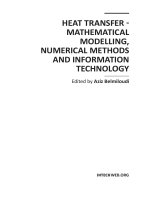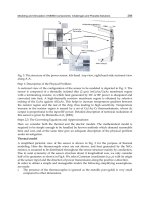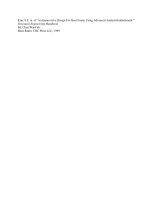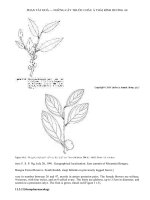Corrosion of Ceramic and Composite Materials Part 1 pptx
Bạn đang xem bản rút gọn của tài liệu. Xem và tải ngay bản đầy đủ của tài liệu tại đây (218.26 KB, 28 trang )
Corrosion of
Ceramic and Composite
Materials
Copyright © 2004 by Marcel Dekker, Inc.
CORROSION TECHNOLOGY
Editor
Philip A.Schweitzer, P.E.
Consultant
York, Pennsylvania
1. Corrosion and Corrosion Protection Handbook: Second Edition,
Revised and Expanded, edited by Philip A.Schweitzer
2. Corrosion Resistant Coatings Technology, Ichiro Suzuki
3. Corrosion Resistance of Elastomers, Philip A.Schweitzer
4. Corrosion Resistance Tables: Metals, Nonmetals, Coatings,
Mortars, Plastics, Elastomers and Linings, and Fabrics: Third
Edition, Revised and Expanded (Parts A and B), Philip
A.Schweitzer
5. Corrosion-Resistant Piping Systems, Philip A.Schweitzer
6. Corrosion Resistance of Zinc and Zinc Alloys, Frank C.Porter
7. Corrosion of Ceramics, Ronald A.McCauley
8. Corrosion Mechanisms in Theory and Practice, edited by
P.Marcus and J.Oudar
9. Corrosion Resistance of Stainless Steels, C.P.Dillon
10. Corrosion Resistance Tables: Metals, Nonmetals, Coatings,
Mortars, Plastics, Elastomers and Linings, and Fabrics: Fourth
Edition, Revised and Expanded (Parts A, B, and C), Philip
A.Schweitzer
11. Corrosion Engineering Handbook, edited by Philip A.Schweitzer
12. Atmospheric Degradation and Corrosion Control, Philip A.
Schweitzer
13. Mechanical and Corrosion-Resistant Properties of Plastics and
Elastomers, Philip A.Schweitzer
14. Environmental Degradation of Metals, U.K.Chatterjee, S.K.Bose,
and S.K.Roy
15. Environmental Effects on Engineered Materials, edited by Russell
H.Jones
16. Corrosion-Resistant Linings and Coatings, Philip A.Schweitzer
17. Corrosion Mechanisms in Theory and Practice: Second Edition,
Revised and Expanded, edited by Philippe Marcus
18. Electrochemical Techniques in Corrosion Science and
Engineering, Robert G.Kelly, John R.Scully, David W.Shoesmith,
and Rudolph G.Buchheit
19. Metallic Materials: Physical, Mechanical, and Corrosion
Properties, Philip A.Schweitzer
Copyright © 2004 by Marcel Dekker, Inc.
20. Encyclopedia of Corrosion Technology: Second Edition, Revised
and Expanded, Philip A.Schweitzer
21. Corrosion Resistance Tables: Metals, Nonmetals, Coatings,
Mortars, Plastics, Elastomers and Linings, and Fabrics: Fifth
Edition, Revised and Expanded (Parts A, B, C, and D), Philip A.
Schweitzer
22. Corrosion of Ceramic and Composite Materials: Second Edition,
Ronald A.McCauley
ADDITIONAL VOLUMES IN PREPARATION
Copyright © 2004 by Marcel Dekker, Inc.
Corrosion of
Ceramic and Composite
Materials
Second Edition
Ronald A.McCauley
Rutgers University
Piscataway, New Jersey, U.S.A.
MARCEL DEKKER, INC.NEW YORK • BASEL
Copyright © 2004 by Marcel Dekker, Inc.
Transferred to Digital Printing 2004
The first edition was Corrosion of Ceramics (Dekker, 1994).
Although great care has been taken to provide accurate and current information,
neither the author(s) nor the publisher, nor anyone else associated with this
publication, shall be liable for any loss, damage, or liability directly or indirectly
caused or alleged to be caused by this book. The material contained herein is not
intended to provide specific advice or recommendations for any specific situation.
Trademark notice: Product or corporate names may be trademarks or registered
trademarks and are used only for identification and explanation without intent to
infringe.
Library of Congress Cataloging-in-Publication Data
A catalog record for this book is available from the Library of Congress.
ISBN: 0-8247-5366-6
Headquarters
Marcel Dekker, Inc., 270 Madison Avenue, New York, NY 10016, U.S.A.
tel: 212–696–9000; fax: 212–685–4540
Distribution and Customer Service
Marcel Dekker, Inc., Cimarron Road, Monticello, New York 12701, U.S.A.
tel: 800–228–1160; fax: 845–796–1772
Eastern Hemisphere Distribution
Marcel Dekker AG, Hutgasse 4, Postfach 812, CH-4001 Basel, Switzerland
tel: 41–61–260–6300; fax: 41–61–260–6333
World Wide Web
The publisher offers discounts on this book when ordered in bulk quantities. For
more information, write to Special Sales/Professional Marketing at the head-quarters
address above.
Copyright © 2004 by Marcel Dekker, Inc. All Rights Reserved.
Neither this book nor any part may be reproduced or transmitted in any form or by
any means, electronic or mechanical, including photocopying, microfilming, and
recording, or by any information storage and retrieval system, without permission
in writing from the publisher.
Current printing (last digit):
10987654321
Copyright © 2004 by Marcel Dekker, Inc.
To
my father
Harry Sylvester McCauley
1909–1966
Copyright © 2004 by Marcel Dekker, Inc.
Preface to the Second Edition
Although a better understanding of the mechanisms of corrosion has
occurred over the past ten years since the publication of the first edition
of this book, corrosion still remains a major problem. One area in
which some advances have been made is the understanding of the
weathering mechanisms of building materials, especially where related
to monuments of the past. The weathering of building materials has
(Corrosion of Specific Crystalline Materials). Although the work on
weathering of building materials has been done predominantly by
civil engineers, it should be of interest to the ceramic engineer. More
information has become available concerning the corrosion of
composite materials of all types. The strong interest in composites
materials has been enhanced by the aerospace industry and the military.
composite materials. In addition, new sections have been added on
all chapters where appropriate.
v
Copyright © 2004 by Marcel Dekker, Inc.
been added as new sections in Chapters 2 (Fundamentals) and 5
Because of this, a whole new chapter (Chapter 7) has been devoted to
bioceramics (Chapter 5). New literature sources have been added to
The first edition of this book was written to be used primarily as a
reference book. Questions have been added at the end of the most
chapters and additional examples have been included along with
recommended reading lists so that this second edition may also be
used as a textbook for either a senior level undergraduate or a graduate
course on corrosion.
Ronald A.McCauley
vi Preface to the Second Edition
Copyright © 2004 by Marcel Dekker, Inc.
Preface to the First Edition
One of the most important problems confronting engineers today is
the development of materials that are reliable under various
environmental conditions. In some cases these conditions are
considered extremely hostile—very high temperatures, mechanical
loading, and/or aggressive chemical attack. Ambient temperature
aqueous attack can also be extremely detrimental, especially over an
extended period of time, as in the case of hazardous waste disposal.
Engineers and scientists have been combating the attack upon ceramics
of molten glass, molten metals and slags, and molten salts for hundreds
of years with many improvements. Most of these improvements have
occurred through experimentation, eventually finding the material
that worked best. Only during the past 25 years has a true
understanding of the complexities of corrosion of ceramics begun to
develop. Major advances have been made in recent years; however,
the details in many cases are still questionable or at least debatable.
The cost to industry due to corrosion is considerable and only a
thorough understanding of all the complexities of the process will help
vii
Copyright © 2004 by Marcel Dekker, Inc.
to minimize that cost. There will undoubtedly be many applications of
ceramics where the ceramic will be consumed during service, but
maximizing service life will greatly reduce the overall cost.
While several books, mostly in the form of symposia proceedings,
have been published on various aspects of corrosion of crystalline and
glassy ceramics, generally on the newer, advanced materials, none has
addressed the subject in a comprehensive manner. The most significant
works have been reported in the technical literature; however, reading all
the published articles is a formidable task. This book is an attempt to
discuss all aspects of the corrosion of ceramics, but no attempt has been
made to complete an exhaustive literature review. Although not all areas
have been described in great detail, a summary of some of the most
important work has been given with references for the interested reader.
This book is based upon a combination of lecture notes from the
Advanced Refractories course that the author has taught at Rutgers
during the past 15 years and the author’s industrial and consulting
experiences. It is intended predominantly as a reference work for
practicing engineers and research scientists but could also be used as a
text for a graduate-level course in corrosion of ceramics. Any comments
or suggestions about the content of this book will be most welcome.
ACKNOWLEDGEMENTS
The author would like to thank the faculty and students of the
Department of Ceramic and Materials Engineering at Rutgers, The
State University of New Jersey, for many helpful and thoughtful
discussions during the preparation of this book and especially Drs.
John Wachtman and M. John Matthewson for reviewing a portion of
the manuscript and for their valuable suggestions.
The author would like to extend a very special thank you to Mr.
William Englert of PPG Industries, who first introduced the author to
the fascinating field of corrosion of ceramics.
Gratitude must also be extended to Mrs. Mary Guerin for her help
in preparation of the manuscript and to Paul Mort, Robert Sabia, John
Martin, and Ryan McCuiston for their help in preparing the figures.
The author would like to extend a very special thank you to his
wife, Eleanora, and his son, Matthew, for their understanding during
the many long hours required to complete this task.
Ronald A.McCauley
viii Preface to the First Edition
Copyright © 2004 by Marcel Dekker, Inc.
Contents
Preface to the Second Edition v
Preface to the First Edition vii
1 INTRODUCTION 1
2 FUNDAMENTALS 9
2.1 Introduction 9
2.2 Corrosion by Liquids 11
2.2.1 Introduction 11
2.2.2 Crystalline Materials 15
2.2.3 Glasses 47
2.3 Corrosion by Gas 56
2.3.1 Crystalline Materials 56
2.3.2 Vacuum 63
2.3.3 Glasses 64
ix
Copyright © 2004 by Marcel Dekker, Inc.
2.4 Corrosion by Solid 65
2.5 Surface Effects 67
2.5.1 Surface Charge 67
2.5.2 Porosity and Surface Area 68
2.5.3 Surface Energy 71
2.6 Acid/Base Effects 77
2.7 Thermodynamics 78
2.7.1 Mathematical Representation 79
2.7.2 Graphical Representation 85
2.8 Kinetics 91
2.9 Diffusion 100
2.10 Summary of Important Concepts 105
2.11 Additional Related Reading 107
2.12 Exercises, Questions, and Problems 108
References 109
3 METHODS OF CORROSION ANALYSIS 123
3.1 Introduction 123
3.2 Laboratory Test vs. Field Trials 124
3.3 Sample Selection and Preparation 126
3.4 Selection of Test Conditions 129
3.5 Characterization Methods 130
3.5.1 Microstructure and Phase Analysis 130
3.5.2 Chemical Analysis 134
3.5.3 Physical Property Measurement 136
3.6 Data Reduction 139
3.7 Additional Related Reading 139
3.8 Exercises, Questions, and Problems 140
References 140
4 CORROSION TEST PROCEDURES 143
4.1 Introduction 143
4.2 ASTM Standards 149
4.3 Nonstandard Tests 162
4.4 Additional Related Reading 163
4.5 Exercises, Questions, and Problems 164
References 164
x Contents
Copyright © 2004 by Marcel Dekker, Inc.
5 CORROSION OF SPECIFIC CRYSTALLINE
MATERIALS 165
5.1 Attack by Liquids 165
5.1.1 Attack by Glasses 165
5.1.2 Attack by Aqueous Solutions 177
5.1.3 Attack by Molten Salts 191
5.1.4 Attack by Molten Metals 197
5.2 Attack by Gases 201
5.2.1 Oxides 202
5.2.2 Nitrides and Carbides 209
5.2.3 Borides 231
5.2.4 Silicides 233
5.2.5 Superconductors 234
5.3 Attack by Solids 234
5.3.1 Silica 234
5.3.2 Magnesia 235
5.3.3 Superconductors 235
5.3.4 Attack by Metals 236
5.4 Additional Related Reading 237
5.5 Exercises, Questions, and Problems 238
References 238
6 CORROSION OF SPECIFIC GLASSY MATERIALS 257
6.1 Introduction 257
6.2 Silicate Glasses 258
6.3 Borosilicate Glasses 271
6.4 Lead-Containing Glasses 275
6.5 Phosphorus-Containing Glasses 276
6.6 Fluoride Glasses 278
6.7 Chalcogenide—Halide Glasses 280
6.8 Additional Related Reading 281
6.9 Exercises, Questions, and Problems 281
References 282
7 CORROSION OF COMPOSITE MATERIALS 291
7.1 Introduction 291
7.2 Reinforcement 295
Contents xi
Copyright © 2004 by Marcel Dekker, Inc.
7.2.1 Fibers 295
7.2.2 Fiber Coatings or Interphases 298
7.2.3 Particulates 299
7.3 Ceramic Matrix Composites 300
7.3.1 Oxide—Matrix Composites 301
7.3.2 Nonoxide—Matrix Composites 309
7.4 Metal Matrix Composites 316
7.5 Polymer Matrix Composites 318
7.6 Additional Related Reading 320
7.7 Exercises, Questions, and Problems 321
References 322
8 PROPERTIES AND CORROSION 333
8.1 Introduction 333
8.2 Mechanisms 337
8.2.1 Crystalline Materials 337
8.2.2 Glassy Materials 339
8.3 Degradation of Specific Materials 345
8.3.1 Degradation by Oxidation 345
8.3.2 Degradation by Moisture 352
8.3.3 Degradation by Other Atmospheres 352
8.3.4 Degradation by Molten Salts 354
8.3.5 Degradation by Molten Metals 358
8.3.6 Degradation by Aqueous Solutions 358
8.4 Additional Related Reading 364
8.5 Exercises, Questions, and Problems 364
References 365
9 METHODS TO MINIMIZE CORROSION 373
9.1 Introduction 373
9.2 Crystalline Materials—Oxides 374
9.2.1 Property Optimization 374
9.2.2 External Methods of Improvement 379
9.3 Crystalline Materials—Nonoxides 382
9.3.1 Property Improvement 382
9.3.2 External Methods of Improvement 384
xii Contents
Copyright © 2004 by Marcel Dekker, Inc.
9.4 Glassy Materials 385
9.4.1 Property Optimization 385
9.4.2 External Methods of Improvement 385
References 387
Glossary 389
Epilog 393
Contents xiii
Copyright © 2004 by Marcel Dekker, Inc.
1
1
Introduction
If we begin with certainties, we shall end in doubt; but if
we begin with doubt, and are patient in them, we shall
end in certainties.
BACON
Most engineers at one time or another will be confronted with
corrosion whether it will be their sole endeavor or whether it
will be a minor unexpected nuisance. The actual study of
corrosion, its causes, effects, and means of elimination is not
as common in the field of ceramics as it is in the field of
metallurgy. Although many engineers study the corrosion of
ceramics all their lives, they normally do not consider
themselves as corrosion engineers, but as ceramic engineers or
process engineers or possibly some other type of engineer. There
are no corrosion engineering courses offered in the several
Copyright © 2004 by Marcel Dekker, Inc.
2 Chapter 1
undergraduate ceramic engineering curricula in the United
States. Even at the graduate level, there are no courses dedicated
to corrosion, although several contain a large amount of
information related to corrosion, such as those related to high-
temperature materials or thermodynamics, etc. There is
definitely no such thing as a bachelor’s degree in Corrosion
Engineering of Ceramic Materials. The American Ceramic
Society does not have a specific division devoted to corrosion
like some other major societies. For example, The
Electrochemical Society has a Corrosion Division. They also
publish a Corrosion Monograph Series.
Throughout the history of the ceramic industries, various
material types or compositions have been used because of some
particular advantageous, intrinsic property. High strength, low
electrical conductivity, or some other property may be the
primary concern for a particular application. However,
excellent resistance to attack by the environment always plays
a role and may, in some cases, be the prime reason for the
selection of a particular material. This is especially true for
those materials selected for furnace construction in the metal
and glass industries.
Almost all environments are corrosive to some extent. For
practical applications, it comes down to a matter of kinetics—
how long will a material last in a particular environment? In
some cases, corrosion may be beneficial, such as in the
preparation of samples by etching for microscopic evaluation,
in chemical polishing to obtain a flat, smooth surface, or in
bioactive materials where reaction with bone or complete
disappearance is required. The selective leaching of the sodium-
and boron-rich phase in phase-separated borosilicate glass to
produce a high silica content glass (called Vycor™ *) is an
excellent example of how corrosion can be put to a beneficial
use. Other examples include dissolution and reprecipitation in
* Corning, Inc., Corning, New York.
Copyright © 2004 by Marcel Dekker, Inc.
Introduction 3
liquid phase sintering (also crystal growth studies) and the
dissolution of various raw materials in molten glass in the
manufacture of glass products.
The proper selection of materials and good design practices
can greatly reduce the cost caused by corrosion. To make the
proper selection, engineers must be knowledgeable in the fields
of thermodynamics, physical chemistry, electrochemistry, and
even meteorology. In addition, engineers must be familiar with
the corrosion testing of materials, the nature of corrosive
environments, the manufacture and availability of materials,
and have a good sense of the economics of the whole process.
There is a growing need in many ceramic applications to be
able to predict the service life based upon laboratory tests.
The limiting factors in making such predictions are more often
than not due to a lack of a thorough knowledge of the industrial
operating conditions rather than to devising the proper
laboratory test. A thorough knowledge of the microstructure
and phase assemblage of the material, however, is critical to
an understanding of the corrosion that may take place. The
National Science Foundation has provided funding to several
universities* to develop a Digital Library of Ceramic
Microstructures (DLCM), which, when completed, will be a
tremendous aid to the engineer involved in corrosion studies.
This library will contain, in addition to selected micrographs,
chemistry, phases, and some properties. Access to the database
will be via the Internet. Although a material may be listed in
some handbook as having excellent resistance to some
particular environment, it is important to know the form of
the material. Were the data listed for a single-crystal, a powder,
or a dense (or porous) sintered component? Were there any
* University of Dayton Research Institute has the primary role. Georgia Institute
of Technology, North Carolina A&T State University, University of Missouri-
Rolla, along with Mechanical Test Instrumentation & Control are supplying
the information.
Copyright © 2004 by Marcel Dekker, Inc.
4 Chapter 1
secondary phases present or was it a pure material? The form
and processing of a material will affect its corrosion.
The cost of corrosion to ceramics in the United States is
enormous; however, in many cases, this corrosion is looked
upon as a necessary expense in the production of some product.
For example, the corrosion of the refractories in a glass melting
furnace is an expected phenomenon. These furnaces are shut
down periodically to replace the worn-out materials. Not only
is the cost of the refractories involved, but also the cost of the
tear out, the cost of the reconstruction, and the cost of any
lost production is involved. The total cost of such a repair can
amount to as much as $10 million or more for a single furnace.
Fig. 1.1 shows an average estimate of the percentages for labor
and materials for a typical furnace repair. Business interruption
costs have not been included since these will vary considerably
depending upon the product being produced and the size of
the furnace. The downtime for repairs also varies considerably
depending upon the extent of the repair, but varies between 1
and 3 months. The cost due to business interruption can
amount to as much as $1 million per month. There are,
however, a few things that add a credit to the costs of a repair,
FIGURE 1.1 Glass furnace repair estimated cost percentages.
Copyright © 2004 by Marcel Dekker, Inc.
Introduction 5
such as the fuel and raw materials saved during the shutdown.
Thus it should be obvious that the equation to determine the
exact costs of a particular repair is quite complex. The total
cost of such repairs can never be eliminated; however, it can
be greatly reduced by the proper selection of refractories and
the proper operation of the furnace. There are times when the
corrosion of the refractories goes unnoticed and failure occurs
prematurely. Since furnaces are insured against premature
failure, very large insurance claims have been filed. In addition
to the costs related to the refractories, construction, and lost
production are the costs related to additional cleanup due to
the failure and the costs of insurance adjusters and lawyers.
The cost of such a failure can exceed $20 million.
Environmental problems can also add to the total cost of
corrosion. For example, a trend toward the use of nonchrome-
containing refractories for furnace construction has been
ongoing for about the past 20 years. Used refractories have, in
the past, been disposed of by burying them in landfills. Chrome-
containing refractories have the potential of contaminating
groundwaters with hexavalent chrome, a carcinogen. If
chrome-containing refractories are used, upon disposal, they
must be hauled to toxic waste dumps with an added cost of
disposal. To eliminate this problem, some industries have been
leaning toward the use of other materials for the construction
of their furnaces. In some cases, the replacement material does
not last as long as the chrome-containing material, thus
shortening the time between repairs and adding to the cost.
The products of corrosion may enter the product being
manufactured and lower the quality of the product or decrease
the yields. Although this is a cost due to corrosion, it is one
that is extremely difficult to quantify. Although no accurate
numbers are available for the annual cost to industry for the
corrosion of ceramic materials, an estimate of $2 billion does
not seem unreasonable. Only through the intelligent selection
of ceramic materials can the cost of corrosion be minimized.
This intelligent selection of materials can be obtained only
through a thorough understanding of all the complexities of
Copyright © 2004 by Marcel Dekker, Inc.
6 Chapter 1
ceramic materials and the effect that the environment has upon
them.
The corrosion of ceramic materials has not been as well
categorized as it has been for metals. Similar terms do, however,
appear in the literature. The more common types referred to
in the literature are diffusion corrosion, which is very similar
to concentration cell corrosion in metals, galvanic cell
corrosion, grain boundary corrosion, and stress corrosion. A
more common trend in ceramic materials is to group corrosion
under a more general mechanism, such as dissolution corrosion
(i.e., corrosion of a solid by a liquid). In this type of corrosion,
diffusion, galvanic cell, grain boundary, and stress corrosion
may all be present.
There are also many words used to describe corrosion, and
if one is looking for information on the subject of corrosion of
a particular material, a search including many of the following
words should be performed: dissolution, oxidation, reduction,
degradation, deterioration, instability, decomposition,
consumption, and erosion. Although erosion is technically not
the same as corrosion, being a physical effect rather than a
chemical one, erosion, in many cases, provides a means for
continued corrosion.
Corrosion of ceramic materials and its relationship to
various property degradation does not receive as wide a
recognition as it probably should at the various technical and
professional society meetings. For example, only about 2.5%
of the approximately 1500 presentations at the 2002 Annual
American Ceramic Society meeting were devoted to topics
related to corrosion. As can be seen from Table 1.1, the
percentage of presentations on corrosion has been between
4.5% and 2.5% during the decade of the 1990s. The data are
truly not sufficient to conclude that a trend exists. Although
the main topic of interest changes somewhat from year-to-
year, hazardous waste materials appear to remain a major
area of interest. Selecting a major topic is complicated by the
fact that areas often overlap, for example, general glass
durability vs. hazardous waste glass leaching. At meetings of
Copyright © 2004 by Marcel Dekker, Inc.
8 Chapter 1
1.1 EXERCISES, QUESTIONS,
AND PROBLEMS
1. List the different fields that an engineer might want to
study to be proficient in evaluating corrosion
problems.
2. List all the various courses taught in a standard ceramic
engineering curriculum that might contain information
related to corrosion.
3. Discuss whether it is more important to know whether
a material will corrode or how long it will last.
4. Discuss several applications where the corrosion is a
beneficial factor rather than a problem. Find several
applications not listed in the text.
5. Develop an equation that represents all the various
factors involved in determining the total cost of a
particular corrosion problem. Pick a particular product
and try to find as much information as possible
concerning the actual costs.
6. Discuss the relationship of erosion to corrosion and
how it can be a major actor in the overall process of
corrosion.
Copyright © 2004 by Marcel Dekker, Inc.
9
2
Fundamentals
Everything should be made as simple as possible, but not
simpler.
ALBERT EINSTEIN
2.1 INTRODUCTION
Corrosion of ceramics can take place by any one or a
combination of mechanisms. Various models have been
proposed to describe these mechanisms, several of which will
be discussed below. In general, the environment will attack a
ceramic, forming a reaction product. The reaction product may
be either solid, liquid, gas, or any combination of these. This
reaction product may remain attached to the ceramic or it may
be fugitive, in the case when gaseous species make up the
reaction product, or it may be a combination of both. When
Copyright © 2004 by Marcel Dekker, Inc.
10 Chapter 2
the reaction product remains as a solid, quite often it forms a
protective layer toward further corrosion. At other times, for
example, if the reaction product is a combination of solid and
liquid, this reaction layer may be removed through the process
of erosion. Thus to analyze corrosion, one must have some
idea of the type of processes that are in operation. When the
reaction product remains as an intact interfacial layer, analysis
is relatively easy. When gaseous species are formed, the
consumption of the ceramic manifests itself as a weight loss.
An understanding of the mechanism, however, requires analysis
of the evolved gases. Many times, the interface formed is very
porous and/or friable requiring special care in preparing
samples for analysis. Because of the various processes that may
take place during corrosion, there is no one general model that
can explain all cases of corrosion. In addition, a single ceramic
material will react differently to different environments and
thus there is no single explanation for the corrosion of a
particular material for all environments. It is also true that the
manufacturing history of a ceramic material will affect its
performance. This may manifest itself, for example, as a low
corrosion-resistant grain boundary phase or a pore size
distribution that greatly increases the exposed surface area to
corrosion. Thus it should be obvious that a simple all-
encompassing general theory of corrosion of ceramics does
not exist and, because of the nature of corrosion and ceramics,
will most likely never exist. There does, however, appear to be
a common thread connecting all the various studies that have
been reported. That is, corrosion is dependent upon the
structural characteristics of the material. The more compact
or tightly bonded materials corrode less whether they are glasses
or crystalline materials. Thus it appears that if a general theory
is to be developed, a comprehensive investigation of single
crystals and some structurally well-characterized glasses should
be investigated.
Corrosion, being an interfacial process, requires a thorough
understanding of the surface structure of the material being
corroded. Thus the study of single crystals is the best method
Copyright © 2004 by Marcel Dekker, Inc.
Fundamentals 11
to determine the fundamentals of corrosion mechanisms. It is
not always possible, however, to obtain single crystals of
sufficient size for appropriate measurements. Although the
crystal surface characteristics determine short-term corrosion
behavior, they may not be as important for long-term corrosion.
Single crystals do lend themselves to evaluation of the effects
that various dopants and defects (e.g., dislocations) have upon
dissolution kinetics.
When attempting to understand the corrosion of a ceramic,
it is a good idea to remember some of the fundamental concepts
of chemistry that are too often forgotten. The following are
just a few concepts that go a long way in helping one to
understand corrosion:
1. A ceramic with acidic character tends to be attacked by
an environment with a basic character and vice versa.
2. The vapor pressure of covalent materials is generally
greater than that of ionic materials and therefore tend
to vaporize or sublime more quickly.
3. Ionic materials tend to be soluble in polar solvents*(e.g.,
salt in water) and covalent materials tend to be soluble
in nonpolar solvents (e.g., SiC in hexane).
4. The solubility of solids in liquids generally increases
with increasing temperature.
2.2 CORROSION BY LIQUIDS
2.2.1 Introduction
The solubility of materials in liquids can be obtained from
phase diagrams, which give the saturation composition at a
given temperature. Unfortunately, for many practical systems,
phase diagrams are either very complex or nonexistent. Many
data are available, however, for two- and three-component
* Polar solvents have a high dielectric constant, whereas nonpolar solvents
have a low dielectric constant. At 20°, the dielectric constant of water is 80
and that of hexane is 1.874.
Copyright © 2004 by Marcel Dekker, Inc.









